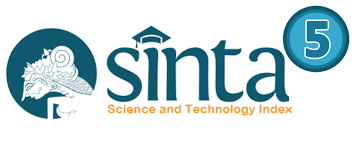HUBUNGAN KEKURANGAN ENERGI KRONIK (KEK) DENGAN STUNTING DI WILAYAH PUSKESMAS MOJOTENGAH
DOI:
https://doi.org/10.30606/jmn.v13i1.3256Keywords:
KEK, Stunting, HPKAbstract
Background: Stunting is a condition that occurs in toddlers who experience growth failure due to chronic malnutrition during the First 1000 Days of Life (HPK). This can be influenced by maternal factors with a state of Chronic Energy Deficiency (KEK). According to WHO (2016), an estimated 156 million children worldwide suffered from stunting in 2015 or 23% of all children worldwide. Objective: to determine the relationship between KEK and the incidence of Stunting in the Mojotengah Health Center area. Method: this study used a retrospective method with a CrossSectional approach. The study population was stunted toddlers aged 1-4 years in 2022 at the Mojotengah Health Center as many as 367 toddlers. The sampling technique used the Simple Random sampling technique obtained 148 toddler respondents. The measuring instrument used was the documentation sheet from the health center. Data analysis used frequency distribution and the Chi Square test. Research results: Based on the results of the study, it shows that pregnant women with KEK with the incidence of very short child stunting of 66.2% compared to pregnant women with KEK experiencing short child stunting of 33.8%. The conclusion is that there is a relationship between KEK and the incidence of Stunting in children with a p value = 0.013 <0.005. It is recommended that further research can add other factors such as nutrition in pregnant women.
Downloads
References
Aswi, Putri Siti CA,dkk. 2024. Pemodelan Faktor-faktor yang mempengaruhi kasus stunting di Sulawesi Selatan Menggunakan Geographically Weighted Regression. Journal of Statistics and ts Application Vol 5 (2). Doi : Hppts://doi.org/10.20956/ejs4.Vsi2.30142
Anggraeni, Z. E. Y., Kurniawan, H., Yasin, M., & Aisyah, A. D. 2020. Hubungan Berat Badan Lahir, Panjang Badan Lahir dan Jenis Kelamin dengan Kejadian Stunting. The Indonesian Journal of Health Science, 12(1), 51–56.
BPPK. 2018. Hasil Urtama RISKErSDAS 2018. Rertrierverd from http://www.derpkers.go.id/rersourrcers/download/info-terrkini/materri_rakorpop_2018. Hasil Riskersdas 2018
Dewi, Ni Luh Made Asri., Ni Nengah Handika Primadewi. 2021. Kejadian stunting Pada Balita Usia 12-36 Bulan. Jurnal Keperawatan Jiwa (JK): Persatuan Perawat Nasional Indonesia. Vo. 9. No 1. Hal. 55-60.
Dinkes Wonosobo. 2021. Profil Kesehatan Kabupaten Wonosobo. Wonosobo
Erna K. 2023. Optimaslisasi Tim Pendamping Keluarga Dalam Upaya Pencegahan stunting di Puskesmas Kembaran I. Prosiding seminar Nasional dan Call for papers”pengembangan sumber daya pedesaan dan kearifan local berkelanjutan XIII. Purwokerto.
Fikawati, S., Syafiq, A. Dan Karisma K. 2015. Gizi Ibu dan Bayi, Jakarta: Rajawali Pers.
Indrawati, A & Azam. 2023. Dampak Status Ekonomi Pada Status Gizi Balita. Jurnal keperawatan Widiagantari
Indriyati, L., Juhairiyah, Hairani, B., & Fakhrizal, D. 2020. Gambaran Kasus Stunting Pada 10 Desa Di Kabupaten Tanah Bumbu Tahun 2018. Jurnal Kebijakan Pembangunan, 15(1), 77–90. https://doi.org/10.47441/jkp.v15i1.57
WHO, W. 2020. Monitoring Heralth For Ther SDGs Surstainabler Derverlopmernt Goals. World Heralth Statistics.
Tamir Tadesse T dkk. 2024. Prevalence of child hood Stunting and Determinants in low middle income African countries Evidence from standard Demographic and Health Survey. Plos One, 25;19(4).doi.10.1371/journal pone 0302212
Ismawati, Vinny., Fitri Dian Kurniati., Suryati., Eka Oktavianto. 2021. Hubungan Stunting Pada Balita Dipengaruhi Oleh Riwayat Kurang Energi Kronik Pada Ibu Hamil. Syifa’ MEDIKA. Nol.11., No.2. Hal. 126-138
Martorell, R. 2017, 3 1. Improved Nutrition in the First 1000 Days and Adult Human Capital and Health. American Journal Of Human Biology, 29, 2-24. doi:10.1002/ajhb.22952.
Ratnawati, R., & Rahfiludin, M. Z. 2020. Faktor Risiko Determinan Yang Konsisten Berhubungan dengan Kejadian Stunting Pada Anak Usia 6- 24 Bulan: Tinjauan Pustaka. Amerta Nutrition, 4(2), 85. https://doi.org/10.20473/amnt.v4i2.2 020.85-94
Rahyu, Puspito, Panggih. Casnuri. 2020. Perbedaan Risiko Stunting Berdasarkan Jenis Kelamin. UNRIYO
Downloads
Published
How to Cite
Issue
Section
License
Copyright (c) 2025 romdiyah, Indrawati aristya rini, Dewi Candra Resmi, Ari setyawati

This work is licensed under a Creative Commons Attribution-ShareAlike 4.0 International License.










